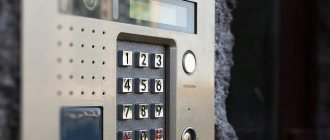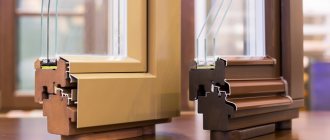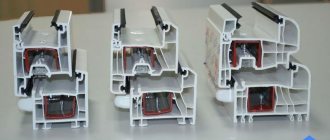Ensuring the safety of people is one of the most pressing modern problems. To inform people in houses, apartments or offices about visitors, a video call becomes an indispensable device. It is especially important to feel protected for those who, returning home after a busy day at work, want to be in a comfortable environment and not have to deal with uninvited guests. The models produced by manufacturers today, in addition to their main purpose, can perform a number of useful functions.
Video doorbell to apartment
Why install a camera?
If you are sure that nothing will happen to your apartment or you are a visionary and know in advance who comes to visit in the morning, then there is no need. In all other cases, it’s worth thinking about:
- Video intercom. The only thing worse than uninvited guests are other unwanted individuals. The camera is a great way to find out who is on the other side of the barricades without leaving your seat
- Amulet against burglary . Who would think of clearing out an apartment if the peephole of a video camera is staring at them from above? Even if the camera does not record video to a hard drive or to the cloud, thieves will not know about it and the fame of Ocean’s friends will not threaten them
- Black mark for bullies . Staircase parties under video camera surveillance are gradually fading away
Types of devices
There are different types of motion sensors, differing in a number of criteria. According to the principle of action they are:
- Ultrasonic. They analyze space using ultrasound, which is elusive to human hearing. If an object comes within the range of the device, the reflected signal changes frequency and the device reacts.
- Microwave. They are triggered when the radio frequency waves change.
- Infrared. They react to the heat emitted by the bodies of living objects. During the cold season, they may malfunction.
- Active. Several infrared beams continuously scan the space for the presence of a moving object.
By type of construction:
- Single-position. One housing simultaneously houses both a transmitter and a receiver. Monitors the location of living objects from one point.
- Two-position. The receiver and transmitter are located in two different housings, which allows the device to monitor the territory from several points.
- Multi-position. Several blocks are installed in several places at once. This is especially true for security systems.
According to the type of installation, external sensors are:
- Ceiling. Allows you to cover the maximum area, as the range is 360 degrees.
- Wall-mounted. They can detect an object at a distance of about 8 meters, and the viewing angle is about 100 degrees.
- Angular. Can be installed on external and internal corners of the building. Often used to control entry to a territory.
In addition, there may be an outdoor wireless or wired sensor. The advantage of the first is that there is no need to connect to the network; they operate from their own power source, but you will have to constantly monitor the charge level.
How to choose a camera?
We will only consider external video cameras, because hidden video surveillance is prohibited. Therefore, there is no point in considering clever camouflaged mini-cameras - you can easily fall under the criminal code of the Russian Federation. The only thing that can be used in this case is a video eye.
How to choose a camera to install? The form factor and viewing angle will not play a special role here - you will need (and are allowed - more on this below) to monitor only a small area in front of the front door, so we will only rely on resolution. Let's go to the catalog https://ultrasb.ru/oborudovanie_dlya_videonablyudeniya and start choosing. What criteria are we interested in when choosing a camera for the front door:
- We need an IP camera with PoE (Power over Ethernet) power supply
- Ability to record in HD/FulHD quality (720p/1080p)
- The presence of a motion sensor (recording only when movement occurs in the frame)
- Availability of a built-in microphone or the ability to connect an external one
- Illumination for work at night.
- Private zones function. Allows you to specify areas of video surveillance that should not be recorded by painting this restricted area
Is it possible to install a street camera?
Yes, such cameras are quite suitable. As an example, consider the FX-IPC-C20VP-IR LS IP video camera. It is intended for installation outdoors, but this is why it is suitable for us - the housing of “outdoor” cameras and FX-IPC-C20VP-IR LS, among other things, is made in a high-strength metal hermetic casing. This will be additional protection against vandals
In addition, the camera has a good viewing angle (from 97 to 33 degrees horizontally). Again, why do we need a viewing angle in the entrance? This may be necessary if residents begin to complain that the camera is pointing “in the wrong direction” (we’ll talk about this in more detail later). To protect yourself from slander from neighbors, the camera has another necessary function - “Private Zone”, the setting of which will allow you not to film an area that does not belong to your property.
New generation video systems
Leganza Smart steel door with built-in patented video surveillance system
Modern technological advances have made available more advanced surveillance systems for the area adjacent to the apartment (house). For those who need a serious level of security, ready-made door structures with high resistance to burglary and surveillance systems with an LCD screen built into the opening doors from the inside have been created.
Models equipped with the latest technology are expensive, and they are produced by both foreign companies and Russian manufacturers: LEGANZA SMART, Stella, Jaguar and others.
On the inside of the metal entrance doors there are two liquid crystal screens, which display the image transmitted by video eyes or external cameras. The presence of monitors does not reduce the durability and reliability of the door, since they are located in a place inaccessible to intruders. The choice of a model with a peephole or an external camera depends on the desire to camouflage or leave the observation system visible.
High-precision cameras and high-quality monitor screens allow you to clearly view the surroundings within a radius of 12-15 meters from installed outdoor devices. Objects, people and events are conveyed from different angles without distorting color or shape. Built-in screens look stylish and do not spoil the door design at all. They are covered with tinted anti-vandal glass, which protects them from damage without protruding above the level of the main panel. The mirror properties of the panel hide its specific purpose when switched off, but do not interfere with obtaining an excellent image when activated.
The Leganza Smart BIO model with a biometric fingerprint sensor is a comfortable solution for a modern entrance door
As already mentioned, the external cameras of the system can be hidden or remote. Hidden models are made in the shape of a peephole and mounted in the usual place of the opening sash. From the outside, they are indistinguishable from ordinary viewing devices, but are capable of recording everything that happens in their field of “vision” on special devices and transmitting information to owners online to mobile devices. The disadvantage of peephole video cameras is their small viewing area.
How legal is this?
The most important question that comes up when installing a camera on a landing is is it even legal? As such, there is no law engraved on tablets. Seriously, there is no clear definition of what is “legal” to install a camera in a hallway.
The Constitution is very inconsistent in this regard. Article 23 guarantees everyone the right to privacy, while the next one, Article 24 , prohibits the collection, storage, use and dissemination of information about a person’s private life without his consent. In general, the legality of installing a camera, if you look at it from the point of view of judicial practice, is a lottery.
Let's look at what we will rely on. There are only a few theses:
- The legality of installing a camera (in the entrance) is determined only by the court, and not by Aunt Zina from the first floor
- The very fact of installing a video camera aimed at a security object or placed for the purpose of protecting the object is absolutely legal. It is precisely the violation of the privacy of those who may be accidentally filmed by your camera that is illegal, unless, of course, they have given consent on paper to the processing of their personal data and permission to film in particular.
- The following rule follows from judicial practice: if the filming is carried out “in the open” and in no way records the entrance to the neighbor’s apartment, then there is no sense of any interference with his private life (appeal ruling dated September 22, 2015 in case No. 33-13488/2015 ). The court rejected the plaintiff's claims because in this case, she only filmed the actions on the staircase and could not film either the interior of the neighbor’s apartment or him going out to buy bread
- You have the following arguments in favor of installing a camera: Art. 45 of the Constitution of the Russian Federation, which states that every citizen has the right to protect his interests by any means not directly prohibited by law and Art. 36 of the Housing Code of the Russian Federation - the adjacent territory is a common place, and staircases, entrances and other common property belong to the residents of the house on the right of common shared ownership.
Total:
The law does not prohibit installing a video camera in the entrance to protect your property, if the rights of neighbors to privacy are taken into account and they are not violated. Specifically, Part 1 of Art. 23 of the Constitution of the Russian Federation, which has already been described above, is a secret regarding personal life and other related nuances. If we translate it into a practical plane, then during installation it is necessary that the camera lens only captures the staircase, the entrance foyer and does NOT include the neighbor’s door, the way he leaves or enters the apartment and does not record the interior of the apartment
[adace-ad id=”5222"]
Some nuances during installation and operation
As already mentioned, a digital video peephole connected to a phone is quick and easy to install; it is much more difficult to configure it correctly. Before connecting the Wi-Fi video peephole, you need to download the corresponding application to your phone; bb-mobile is suitable for Android, and for iOS you can download Rollup Smart-Doorbell.
Preparing to connect the video eye:
To configure your smartphone, you need to launch the selected application, for example, Rollup. Then run a search and find your video peephole. In the submenu labeled “user binding window” you will find the device number, after which all you have to do is enter and confirm the pairing.
But that’s not all, you need to connect your smartphone to the WiFi network via a router, the algorithm is something like this:
- Find the Wi-Fi icon in the menu and click on it;
- A menu will open where you need to click on Rollup (the name of the downloaded application);
- Next, the device will ask you for a Wi-Fi password, you need to enter it;
- Waiting for a connection to the router;
- Save all settings.
Do I need approval from the management company (housing department/homeowners association)?
The Housing Code (Article 36, Part 1) says that the owners of premises in an apartment building have the right of ownership to common property, except for inter-apartment landings, stairs, elevators, elevator and other shafts, and corridors. The question is how you will mount the camera. If it is on part of the landing (and most likely this will be the case), then you must coordinate the installation with the organization that operates the housing stock (housing and communal services, housing department, owner's association, developer organization, etc.)
If you install a camera whose bracket will be attached directly to the door (this is already your property), then no notifications to the management company are needed. However, we recommend that you still coordinate this matter if, for example, the entrance cleaner is caught on camera. May have problems.
Additional Model Features
Experts recommend installing a door video peephole with a camera and a sound signal. This will allow you to communicate with the visitor from different places in the house. This is especially true for private houses with a large area. If you install a video device simultaneously with an electronic lock, you will get a convenient intercom.
Additionally, devices can be set to automatically take photographs of suitable people or start video recording. The functions will be activated if there is movement near the front door. In addition to receiving SMS messages, you can set up mms alerts when transmitting bulk information. The configured video archive can record the date and time of shooting.
It will be very convenient to use the answering machine mode. A signal about the arrival of guests can be sent to your smartphone and you can call the smart device and chat with the visitor.
What if the residents are against it?
What to do if residents sound the alarm, write collective complaints and resist the installation of a camera in every possible way? But nothing - you don’t need the residents’ consent to install a camera. Regulatory legal acts do not provide for restrictions on the installation of video cameras by individuals, as well as a unified procedure for video recording for various purposes, such as protecting their property or monitoring a land plot. In addition, video cameras are not actions for the use of common property, which by law require the consent of shared owners. There is also no need to hang a sign. But you must take into account that there are still limitations:
- You cannot install a camera so that it is aimed at the apartment of a neighbor in the stairwell ( Federal Law “On Personal Data”, paragraph 1 of Article 3 ), more precisely, his actions (entering and leaving the apartment) should NOT be captured by the camera.
- Let's say you can't install a camera without the possibility of your apartment or your neighbor's actions being captured in the frame. Then you will need his written consent to process personal data ( Federal Law “On Personal Data”, clause 1, part 1, article 6 )
If you install a camera in circumvention of these restrictions, then you will definitely lose the case and the camera will have to be dismantled. This is the best case scenario. At worst, you could face criminal charges for violating privacy. The Criminal Code under this article regulates a fine of 200 thousand rubles, or imprisonment for up to 2 years.
Here the truth is most likely on your side, because... Assessing legality is very difficult. Proving that a camera violates a neighbor’s rights is even harder. In general, in order to pull this turnip out of the ground, the neighbors will have to run around and try hard to prove that you are encroaching on their privacy (remember, if you have met the conditions above)
Video-eye
A miniature camera in the form of a door peephole is mounted in place of a conventional device and is practically no different from it in appearance. There are three types of products, differing in their characteristics:
- Micro-sized video eyes with low cost and low resolution of the transmitted image (no more than 300 TVL). The models are easy to install, but the weak camera capabilities do not allow visitors to be clearly seen in poor lighting conditions.
- Video eyes with a medium-level resolution (from 300 to 420 TVL) are capable of transmitting good quality images even with a weak light source.
- Eyes with highly sensitive cameras transmit a detailed image of guests at any time of the day.
Depending on the type of peephole and its cost, owners can receive a color or monochrome picture on the screen. Electricity is supplied to the product from a regular network, or from rechargeable batteries, allowing the system to be autonomous. The eyes are installed directly on the door leaf or are located in a special rigid housing. Expensive models are equipped with illumination in the infrared spectrum - with its help you can distinguish faces in the dark and obtain high-quality photo or video images of night visitors.
Surveillance devices consist of two parts, located indoors and outdoors. The external part takes pictures of visitors and transmits the image to a small screen located in a block inside the room.
Video peephole equipment
The attractiveness of video peepholes lies in their small size and the possibility of discreet installation on the door of a regular living space.
What if I am against my neighbor installing a camera?
A mirror situation, in which you don't want your neighbor to be able to peek at you, can also happen. Here the law, and in particular the civil code and the constitution, may be on your side. What you can refer to:
- Article 23 part 1 of the Constitution of the Russian Federation : Everyone has the right to privacy, personal and family secrets, protection of their honor and good name.
- Article 24 part 1 of the Constitution of the Russian Federation : Collection, storage, use and dissemination of information about the private life of a person without his consent is not allowed.
- Article 247 part 1 of the Civil Code of the Russian Federation : Possession and use of property in shared ownership is carried out by agreement of all its participants, and if agreement is not reached, in the manner established by the court.
- Article 304 of the Civil Code of the Russian Federation: The owner may demand the elimination of any violations of his rights, even if these violations were not associated with deprivation of possession.
[a[adace-ad id=»5228"]/p>
Optimal performance for an all-weather sensor
It is more convenient to choose a device when there is a general understanding of the characteristics. For an all-weather outdoor sensor it is:
- mains voltage within standard 220–240 V;
- after activation, the lighting device can burn for up to 10 minutes, but in order not to waste electricity, it is optimal to choose about 3 minutes;
- the range of the capture zone in different types of sensors ranges from 12 to 15 meters;
- the device’s response speed is from 0.5 m/sec - the lower the speed, the greater the likelihood that the sensor will be able to detect a fast-moving object;
- The viewing angle can be up to 360 degrees if a ceiling device is used for lighting;
- all-weather operating mode;
- switched current fluctuates between 1.0–1.5 A.
Sensitivity can be adjusted during installation to suit the individual needs of the client.
Where to buy motion sensors for the street and more
You can purchase sensors either in a specialized store or online in an online store. In the second case, the budget option for purchasing products on the Aliexpress website deserves special attention. For some products there is an option for shipment from a warehouse in the Russian Federation; they can be received as quickly as possible; to do this, when ordering, select “Delivery from the Russian Federation”:
| Automatic IR sensor for security system | IR sensors HC-SR501/505/602 | Light switch with built-in motion sensor |
| Security device with motion sensor and sound alarm | Outdoor wireless IR motion sensor | Motion sensor for LED strip |
Common problems
Sometimes, after installation, the motion sensor does not work as expected. Common problems include:
- After activation, the lighting device does not turn off. To fix the problem, you need to check the delay settings.
- Lack of response to movement. You need to set the maximum value of the LUX regulator. If the sensor starts working, then you need to make adjustments. If not, the device is most likely faulty.
- Incorrect installation. There may be objects between the sensor and the control area that obstruct the signal, which means the sensor will not work as it should. If it is located next to a lighting fixture, false alarms may occur (as well as near heating pipes).
- Lamp burnout. Sometimes the problem of a non-working device is very simple - you just need to replace the lamp.
- Wiring fault. To identify it, you need to carry out diagnostics on all sections of the chain. If a problem is detected, you need to de-energize the system and replace the cable at the fault location.
Sometimes the problem lies in improper use. Most often, high humidity is not taken into account, and water can damage the device.
This device can be a great helper on the street. It will add comfort and ensure safety. The main thing is to take into account all the needs when choosing the device itself and install it correctly.











